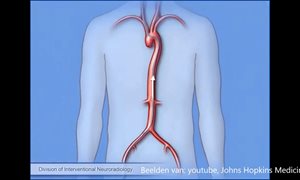What is a brain aneurysm?
An aneurysm is any bulge in the wall of a brain artery. The aneurysm is almost always at the junction of two arteries. It is usually at the bottom of the brain or brain stem. read moreWhat is a brain aneurysm?
The risk of an aneurysm is that it can rupture and bleed.It is not exactly known why one person develops an aneurysm and another does not. We know that it has to do with the wear and tear of the blood vessels and that people with high blood pressure and people who smoke are at greater risk. An aneurysm is not hereditary. However, there are families in which an aneurysm is more common. There are a few rare hereditary diseases that more often cause an aneurysm of the brain.
You can compare an aneurysm to a bicycle tire with a hole in the tire and the inner tube bulging outwards. The aneurysm can rupture and cause a brain hemorrhage (subarachnoid hemorrhage).
- There is a thin area in the wall of a brain artery from birth. You can see this in the picture.
- The blood pressure causes a “lump” on the thin spot in the vascular wall.
- The aneurysm can rupture and bleed.
- The vein may contract in a spasm.
How common is a brain aneurysm?
International studies have shown that approximately 2 in 100 people have a cerebral aneurysm. In the Netherlands, we know that approximately 7 out of 100,000 people with a brain aneurysm suffer from a hemorrhage. This means that most brain aneurysms do not hemorrhage.
How does a brain aneurysm arise?
In many cases, a brain aneurysm is discovered by accident, for example when investigating another symptom or disorder.
There are also brain aneurysms that cause neurological dysfunctions because they are continuing to grow larger. That is because it presses against the brain, brain stem, or cranial nerves.
Symptoms arise depending on the area or the nerve that gets pressed into.


Tests and diagnosis
If it turns out that you have a brain aneurysm, you will be referred to the neurologist or neurosurgeon specializing in cerebral arteries. The doctor makes an assessment of the risk of the aneurysm hemorrhaging and weighs this against the treatment risk. read moreTests and diagnosis
If it turns out that you have a brain aneurysm, you will be referred to the neurologist or neurosurgeon specializing in cerebral arteries. The doctor makes an assessment of the risk of the aneurysm hemorrhaging and weighs this against the treatment risk. If treatment is being considered, an aneurysm examination is planned in order to identify the aneurysm properly by means of a vascular examination (angiography).
On the basis of this examination, the attending physician will consider a treatment plan. This is done in consultation with neurologists and radiologists specialized in brain vessels. If necessary, they consult and cooperate with national and international colleagues. We will discuss the advice about the treatment with you at the outpatient clinic. Your treatment wishes play an important role in this.
Angiografie


Life with a brain aneurysm
After a brain aneurysm, there are a number of things to consider. read moreLife with a brain aneurysm
-
When a brain aneurysm is discovered, there is often uncertainty about activities that increase the pressure on the head. Examples include flying, diving, going on a roller coaster, pushing, going to the sauna, or having sex. There is no scientific evidence that these activities increase the risk of a hemorrhage from an aneurysm. These activities can therefore be carried out as usual.
-
There is no scientific evidence to suggest that a brain aneurysm increases the risk of bleeding during pregnancy or childbirth.
-
A brain aneurysm is not hereditary, but it does occur in a number of hereditary syndromes such as Marfan syndrome, Ehlers-Danlos syndrome (EDS), and Loeys-Dietz syndrome (LDS). It is also known that a hereditary form of cysts in the kidneys (Autosomal Dominant Polycystic Kidney Disease - ADPKD) increases the risk of a brain aneurysm.
If your doctor suspects that you have an aneurysm due to a hereditary syndrome, you will be referred to a clinical geneticist to investigate and advise you and your family on screening. -
There are legal requirements for the suitability of driving motor vehicles according to the “requirements for fitness to drive” regulation of the health inspection. The CBR (Dutch Central Driving License Office) supervises compliance with this requirement. For an aneurysm that has not hemorrhaged and has no symptoms that affect your ability to drive, there are no restrictions on the use of motor vehicles.
An exception is made for persons with group 2 driver’s licenses with a randomly discovered aneurysm larger than 10 mm. In this case, a specialist’s report is required, in addition to the declaration of health. The maximum driving fitness period is 3 years.
If the symptoms of a brain aneurysm do affect your ability to drive, you will need a specialist report. On the basis of this report, the CBR can decide whether an additional independent medical examination or a driving test is required. Your medical specialist will write the specialized report in addition to the health certificate issued by the CBR. -
High blood pressure and smoking are known to increase the risk of brain aneurysms and aneurysm hemorrhage. If you have been diagnosed with a brain aneurysm, it is advisable to stop smoking and have your blood pressure checked regularly. You can have this done by your general practitioner.
